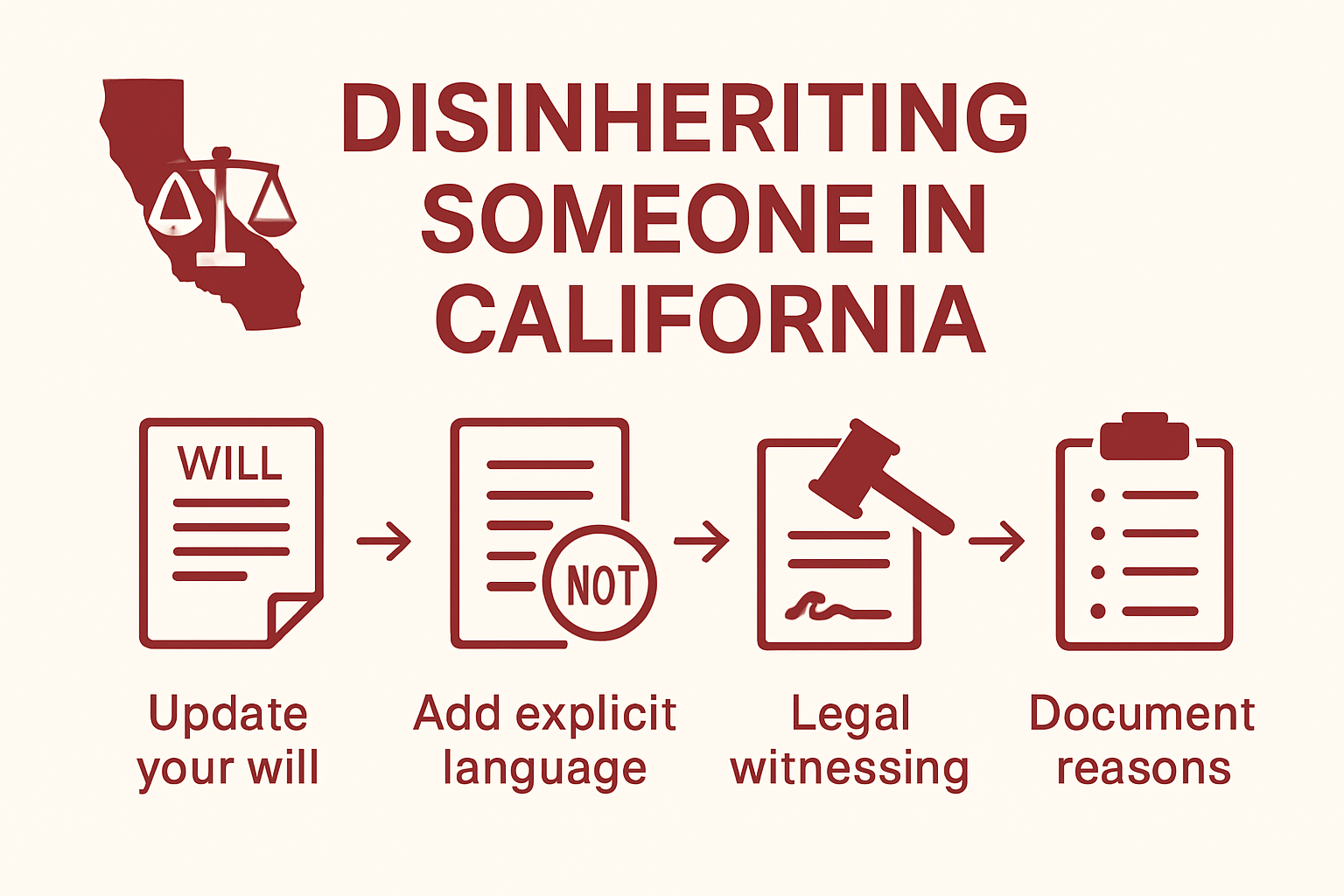
PARENTS & HOMEOWNERS: MY 7-STEP ESTATE PLANNING PROCESS WILL PROTECT YOUR HEIRS
From Creditors, Predators & Bad Choices, And Will Help You Become a (Bigger) Hero to Your Family!



Disinheriting Someone California: Protecting Your Family Legacy 2025
{
“@type”: “Article”,
“author”: {
“url”: “https://ridleylawoffices.com”,
“name”: “Ridley Law Offices”,
“@type”: “Organization”
},
“@context”: “https://schema.org”,
“headline”: “Disinheriting Someone California: Protecting Your Family Legacy 2025”,
“publisher”: {
“url”: “https://ridleylawoffices.com”,
“name”: “Ridley Law Offices”,
“@type”: “Organization”
},
“inLanguage”: “en”,
“articleBody”: “Learn the essentials of disinheriting someone California. Discover your options, protect your legacy, and avoid costly family disputes with clear planning.”,
“description”: “Learn the essentials of disinheriting someone California. Discover your options, protect your legacy, and avoid costly family disputes with clear planning.”,
“datePublished”: “2025-08-08T00:57:21.964Z”,
“mainEntityOfPage”: {
“@id”: “https://ridleylawoffices.com/disinheriting-someone-california-protecting-your-family-legacy-2025”,
“@type”: “WebPage”
}
}
Disinheriting someone in California can feel like a minefield of paperwork and emotional landmines. Shockingly, simply leaving someone out of your will is nowhere near enough to keep them from inheriting under state law. In fact, if you are not crystal clear with your intent, California courts may hand your assets to the very person you wanted to exclude. Want your wishes honored and family disputes avoided? There is a method that makes all the difference.
Table of Contents
- Understanding Disinheritance Laws In California
- Valid Reasons For Disinheriting Someone
- Step-By-Step Guide To Disinheritance
- Protecting Heirs And Avoiding Future Disputes
Quick Summary
| Takeaway | Explanation |
|---|---|
| Explicit Language is Crucial | Clearly state intent to disinherit using unambiguous terms to avoid misinterpretation. |
| Document Everything Thoroughly | Comprehensive legal documentation with rationale minimizes challenges and confusion regarding disinheritance. |
| Legal Guidance is Essential | Engage an experienced estate planning attorney to navigate complex legal requirements and protect your wishes. |
| Communicate Proactively with Family | Open dialogue about disinheritance can help prevent future disputes and misunderstandings within the family. |
| Consider Vulnerable Beneficiaries | Implement strategies like special needs trusts to ensure those unable to manage wealth are protected. |
Understanding Disinheritance Laws in California
Disinheriting someone in California involves complex legal considerations that require careful navigation through state-specific inheritance regulations. The process goes far beyond simply writing someone out of a will. California law provides specific protections and legal mechanisms that can impact how assets are distributed, making it crucial to understand the nuanced landscape of disinheritance.
Legal Foundations of Disinheritance in California
California recognizes an individual’s right to distribute their assets as they see fit, but this right is not absolute. According to the California Attorney General’s Office, without explicit estate planning, assets automatically follow state intestate succession laws. This means that if you do not take specific legal steps, your assets may be distributed contrary to your wishes.
In the landmark case of Estate of Carroll, the California Court of Appeal established a critical precedent: to effectively disinherit an heir, the intent must be clearly stated in the will. Vague language or implicit suggestions are insufficient. The court emphasized that disinheritance requires explicit, unambiguous language that leaves no room for misinterpretation.
Strategies for Effective Disinheritance
Effective disinheritance in California demands more than a simple omission of an heir’s name. Legal experts recommend several strategic approaches to ensure your wishes are honored. The Estate of Flint case illuminated that providing a nominal sum to an heir can sometimes be interpreted as an intent to disinherit, but explicit language remains the gold standard.
Key strategies include:
- Explicit Language: Directly state your intention to disinherit a specific individual, using clear and unambiguous terminology.
- Comprehensive Documentation: Provide detailed reasoning for the disinheritance to minimize potential legal challenges.
- Consider Legal Protections: Be aware of California’s community property laws and potential spousal inheritance rights.
Potential Legal Complications
Disinheritance is not without potential legal challenges. Our guide on estate planning complexities provides deeper insights into the nuanced world of asset distribution. Potential heirs may contest a will, claiming undue influence, lack of testamentary capacity, or other legal grounds. California courts take these challenges seriously and will carefully examine the circumstances surrounding the disinheritance.
The complexity of disinheritance underscores the critical importance of professional legal guidance. Every family situation is unique, and a one-size-fits-all approach can lead to unintended consequences. Working with an experienced estate planning attorney can help you navigate these intricate legal waters, ensuring your wishes are both clearly expressed and legally defensible.
Ultimately, disinheriting someone in California requires a strategic, well-documented approach that leaves no room for misinterpretation. Understanding the legal landscape, using precise language, and seeking professional guidance are essential steps in protecting your family legacy and ensuring your final wishes are respected.
Valid Reasons for Disinheriting Someone
Disinheriting a family member is a deeply personal and complex decision that requires careful legal and emotional consideration. While family bonds are traditionally sacred, there are legitimate circumstances where disinheritance becomes a necessary strategy for protecting one’s estate and legacy.
Family Dynamics and Relationship Breakdown
According to Western Southern Life Insurance, disinheritance can stem from various critical factors. Severe family estrangement, persistent destructive behavior, or complete abandonment are compelling reasons individuals might choose to exclude a potential heir from their estate. This decision is not made lightly but often represents a last resort after years of unresolvable conflicts.
Estrangement can manifest through prolonged periods of no communication, repeated financial exploitation, substance abuse issues that have caused significant family trauma, or fundamental value disagreements that have irreparably damaged relationships. The key is demonstrating a clear, documentable pattern of behavior that justifies the extraordinary step of disinheritance.
Financial and Legal Considerations
Kiplinger’s financial research highlights several nuanced scenarios where disinheritance becomes a strategic financial decision. These include protecting inheritance from potential creditors, preserving government benefits for family members with disabilities, or redirecting assets to more responsible heirs.
Key financial motivations for disinheritance include:
- Protecting Vulnerable Beneficiaries: Ensuring assets don’t compromise critical government assistance programs.
- Creditor Protection: Preventing inherited assets from being immediately seized in legal proceedings.
- Blended Family Considerations: Ensuring children from previous relationships receive appropriate inheritance.
Legal and Emotional Complexity
Our comprehensive estate planning guide emphasizes that disinheritance is not a decision to be made hastily. California law requires explicit, unambiguous language to effectively disinherit an heir. Merely omitting someone’s name is insufficient.
Emotional considerations are equally critical. While legal mechanisms exist to disinherit someone, the psychological impact on family dynamics can be profound. Some individuals choose to include a detailed explanation in their will, providing clarity and potentially mitigating future family conflicts.
Professional legal guidance becomes paramount in navigating these complex waters. An experienced estate planning attorney can help craft language that clearly expresses intent, minimizes potential legal challenges, and ensures your wishes are legally defensible.
Ultimately, disinheritance represents a deeply personal choice driven by complex family, financial, and legal considerations. It requires thoughtful reflection, clear documentation, and strategic legal planning to protect both your estate and your family’s long-term interests.
Below is a summary table comparing common reasons for disinheriting someone as discussed in the article. This table highlights the motivation, typical scenarios, and key legal/emotional considerations for each reason.
| Reason | Example Scenarios | Legal/Emotional Considerations |
|---|---|---|
| Family Estrangement | Prolonged lack of contact, abandonment, value clashes | Must show pattern of behavior |
| Destructive Behavior | Substance abuse, exploitation, unresolved conflict | Requires clear documentation |
| Financial Protection | Preserve benefits for disabled heirs, creditor issues | Use of special trusts, legal safeguards |
| Blended Family Dynamics | Safeguard inheritance for children from prior marriage | Carefully crafted estate plan needed |
| Personal Principles | Irreconcilable value differences, legacy protection | Detailed explanation may reduce disputes |
Step-by-Step Guide to Disinheritance
Disinheriting someone in California requires a methodical and legally precise approach. The process demands careful planning, strategic documentation, and an understanding of complex legal nuances to ensure your final wishes are both clear and defensible.
Preparing Legal Documentation
According to the California Courts Self-Help Guide, the foundation of effective disinheritance lies in meticulous legal documentation. Begin by consulting with an experienced estate planning attorney who can help draft precise language that unambiguously expresses your intent to exclude a specific heir.
Key documentation steps include:

- Comprehensive Will Update: Revise your existing will to include explicit disinheritance language.
- Detailed Explanation: Consider providing a clear, factual rationale for the disinheritance to minimize potential legal challenges.
- Witness Verification: Ensure the will is properly witnessed and executed according to California legal standards.
Crafting Precise Disinheritance Language
California legal precedent emphasizes that disinheritance requires crystal-clear language. Vague or implied statements are insufficient. Your documentation must directly state the intention to exclude a specific heir, using unambiguous terminology that leaves no room for misinterpretation.
Consider including specific provisions such as:
- A direct statement of disinheritance
- Explanation of why the individual is being excluded
- Confirmation that the exclusion is intentional and complete
Legal Safeguards and Potential Challenges
Our comprehensive guide to estate planning highlights the importance of anticipating potential legal challenges. California law provides certain protections for potential heirs, making it crucial to approach disinheritance with strategic foresight.
Practical steps to minimize legal complications include:
- Consulting multiple legal professionals
- Maintaining comprehensive mental health documentation
- Considering a no-contest clause in your will
- Keeping detailed records of family interactions and relationships
Understanding the California Probate Form DE-310 can be crucial in managing property transfer processes. This form becomes particularly important when dealing with estates valued under $166,250, providing a streamlined mechanism for property transfer.
Professional legal guidance is paramount in navigating the intricate landscape of disinheritance. An experienced estate planning attorney can help you craft a strategy that protects your wishes while minimizing the potential for familial conflict and legal challenges.
Remember that disinheritance is not just a legal process but an emotional journey. Approach it with careful consideration, compassion, and a clear understanding of both the legal and personal implications. Your goal is to create a clear, legally sound document that reflects your true intentions while protecting your family’s long-term interests.
Below is a process table outlining the key steps to disinheriting someone in California. This table provides a quick reference to each stage and its focus to help readers better understand the standard procedure.
| Step | Action/Focus |
|---|---|
| 1. Consult an Estate Planning Attorney | Get professional legal advice to ensure compliance |
| 2. Update Will/Trust | Revise documents with explicit disinheritance language |
| 3. Provide Rationale | Consider including factual reasons for disinheritance |
| 4. Execute Proper Formalities | Ensure witnessing and execution meet legal standards |
| 5. Document Capacity & Intent | Maintain mental health and decision documentation |
| 6. Include Safeguards | Use no-contest clauses and support documents |
| 7. Communicate When Appropriate | Decide level of disclosure to family/beneficiaries |
Protecting Heirs and Avoiding Future Disputes
Navigating the complex landscape of disinheritance requires more than legal documentation. It demands a strategic approach that minimizes potential family conflicts, protects vulnerable beneficiaries, and ensures your legacy remains intact.
Proactive Family Communication Strategies
According to Kiplinger’s financial research, managing family dynamics is crucial when considering disinheritance. Transparency can often prevent lengthy legal battles and emotional trauma. While complete disclosure isn’t always possible, providing context for your decisions can significantly reduce the likelihood of future disputes.
Consider these communication approaches:
- Partial Disclosure: Share general intentions without revealing specific financial details.
- Written Explanation: Prepare a separate document explaining your reasoning.
- Mediated Conversations: Engage a neutral third party to facilitate family discussions.
Legal Safeguards Against Contestation
California legal experts emphasize the importance of creating airtight legal protections. Statutory rights provide certain protections for family members, making it critical to craft your estate plan with precision.
Key legal strategies include:
- No-Contest Clauses: Implement provisions that penalize beneficiaries who challenge the will.
- Comprehensive Documentation: Maintain detailed records of mental capacity and decision-making.
- Timing of Estate Planning: Create documents while in good mental health to reduce potential challenges.
Protecting Vulnerable Beneficiaries
Our guide to avoiding probate disputes highlights the importance of considering long-term family dynamics. Some heirs may require special considerations, such as those with disabilities or financial challenges.
Strategies for comprehensive protection include:
- Special Needs Trusts: Create tailored financial arrangements for vulnerable family members.
- Gradual Distribution: Implement staged inheritance provisions.
- Financial Education: Provide resources to help heirs manage potential inheritances responsibly.
San Diego Elder Law experts recommend additional protective measures. Keep beneficiaries separate from estate planning meetings to prevent accusations of undue influence. Document your reasoning comprehensively, creating a clear narrative that supports your estate planning decisions.
Ultimately, protecting your family’s legacy requires a delicate balance of legal precision, emotional intelligence, and forward-thinking strategy. Each family’s situation is unique, demanding a personalized approach that considers both financial implications and long-term relational dynamics.
Professional guidance becomes invaluable in navigating these complex waters. An experienced estate planning attorney can help you develop a comprehensive strategy that protects your wishes, minimizes potential conflicts, and preserves your family’s financial and emotional well-being.

Frequently Asked Questions
What are the legal requirements for disinheriting someone in California?
To effectively disinherit someone in California, you must use explicit and unambiguous language in your will. Simply leaving someone out of your will is not sufficient, as California has specific laws that dictate asset distribution if intent is not clearly expressed.
Can I disinherit my spouse in California?
Disinheriting your spouse in California can be complicated. While you can express your intent to disinherit, community property laws and spousal rights can affect inheritance. It’s essential to consult with an estate planning attorney for tailored advice.
What strategies can help ensure my disinheritance wishes are honored?
To ensure your disinheritance wishes are honored, use clear language in your will, document your reasons for disinheritance, and consider legal safeguards like no-contest clauses. Consulting an experienced estate planning attorney is also recommended.
How can family communication impact the disinheritance process?
Proactive family communication can significantly reduce the likelihood of disputes after your passing. Consider providing explanations for your decisions, possibly with the help of a neutral mediator, to clarify your intentions and mitigate misunderstandings.
Protect Your Family’s Future with Thoughtful Estate Planning
Disinheriting a loved one in California is hard enough without legal confusion or emotional fallout. As the article explained, simple mistakes in your will or unclear language can lead to costly court battles, uncertainty, and financial harm for those you care about most. You deserve peace of mind knowing your wishes are both honored and protected. Trust our team to help you avoid the most common pitfalls and ensure your estate plan stands the test of time. Learn how comprehensive planning can make all the difference by visiting our Estate Planning resources now.

Take the guesswork out of disinheritance or any sensitive estate issue. Secure your family’s legacy and avoid future disputes by consulting the trusted professionals at The Law Offices of Eric Ridley. It only takes one conversation to protect everything you have worked so hard to build for your loved ones. Contact us today to start your personalized plan.
Recommended
- Family Legacy Planning in California: Secure Your Wealth for 2025 – Law Office of Eric Ridley
- Legacy Planning Strategies for California Families 2025 – Law Office of Eric Ridley
- Avoiding Probate Disputes in California: Protect Your Wealth in 2025 – Law Office of Eric Ridley
- Estate Planning for Parents in California: Protecting Wealth in 2025 – Law Office of Eric Ridley
